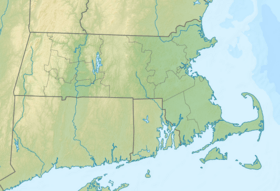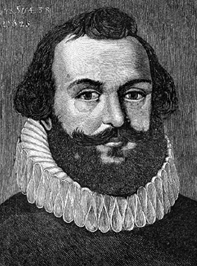Wessagusset Colony facts for kids
Quick facts for kids
Wessagusset Colony
|
|
|---|---|
| Country | United States |
| State | Massachusetts |
| Population
(1623)
|
|
| • Total | Approximately 60 |
The Wessagusset Colony was an early English settlement in New England. It was also known as the Weston Colony or Weymouth Colony. This colony was located in what is now Weymouth, Massachusetts.
About 50 to 60 English colonists started Wessagusset in August 1622. They were not ready for life in a new land. The colony did not have enough food or supplies. It lasted less than a year, ending in March 1623. Many colonists either went back to England or joined the nearby Plymouth Colony.
Wessagusset was the second English settlement in Massachusetts. It was founded six years before the larger Massachusetts Bay Colony. The colony is often remembered for a conflict between Plymouth soldiers, led by Myles Standish, and local Native American groups. This event made relations between the colonists and Native Americans difficult. It was even written about in a famous poem by Henry Wadsworth Longfellow called The Courtship of Miles Standish.
In September 1623, a second group tried to settle at the same spot. This new colony was led by Robert Gorges and was called Weymouth. It also faced problems, and Governor Gorges returned to England. However, some settlers stayed. The area later became part of the Massachusetts Bay Colony in 1630.
Contents
Why Was Wessagusset Colony Started?
The Wessagusset Colony was set up by Thomas Weston. He was a merchant from London who dealt in iron. Weston was part of the Council for New England. This group had helped fund an earlier colony in Maine called the Popham Colony.
Weston also helped the Pilgrims travel to the New World. This was when they were living in the Netherlands. He worked with the Company of Merchant Adventurers of London to arrange their journey.
Making Money Was the Main Goal
Weston's main goal for Wessagusset was to make money. This was different from the Pilgrims, who started Plymouth for religious reasons. Weston believed that families would make a colony harder to manage. So, he chose only strong, able-bodied men for Wessagusset. However, these men did not have much experience living in colonies.
The group included about 50 to 60 colonists, plus some advance scouts. There was also a surgeon and a lawyer. They brought enough supplies to last through the winter.
The First Wessagusset Colony: 1622-1623
An early group of 60 settlers arrived at the Plymouth Colony in May 1622. They had sailed on the Sparrow, an English fishing ship. The team then traveled about 150 miles (240 km) down the coast in a small boat called a shallop.
These colonists stayed briefly in Plymouth. Then, they explored the coast to find a good spot for their colony. They found a place and talked with Chief Aberdecest to get the land. After that, they returned to Plymouth to wait for the rest of the colonists.
The main group of colonists left London in April 1622. They sailed on two ships, the Charity and the Swan. Richard Greene, who was Thomas Weston's brother-in-law, was the first leader. The group reached Plymouth in late June and moved to their settlement the next month. By the end of September, the colony was set up. The Swan stayed in the Weymouth Fore River, and the Charity sailed back to England.
Early Challenges and Hardships
At first, relations between Wessagusset and Plymouth were friendly. The men from Wessagusset even helped Plymouth with their harvest. But soon, people from Plymouth accused the Wessagusset colonists of stealing. Native Americans also complained to Plymouth that the Wessagusset settlers were taking their corn. Plymouth had no power over Wessagusset, so they could only send a warning.
The Wessagusset colony was using up food too quickly. Plymouth's Governor William Bradford reported that the colony was disorganized. It became clear they would run out of food before winter ended. Plymouth also had low supplies because they spent time building defenses instead of growing crops.
To avoid hunger, both colonies decided to trade with the Native Americans together. They used goods brought by the Wessagusset colonists. This trading trip helped a little, and the two colonies shared what they got. In November, Richard Greene died, and John Sanders became the new governor.
By January, the colonists were still trading for food. But they were at a disadvantage. The price of corn went up, and they had to trade their clothes and other important supplies. Some colonists even worked for the Native Americans, building canoes or doing other jobs, just to get food. Ten colonists died during this time.
Conflict and the End of the First Colony
One Wessagusset man was caught stealing by the Native Americans. To show good faith, the other Wessagusset colonists punished him. However, it is not clear if the person punished was actually the one who stole. This event was later made famous in a poem by Samuel Butler.
In February, Governor Sanders asked Plymouth for a joint attack on the Native Americans. But Governor Bradford of Plymouth refused. Much of the story of this first colony comes from a report written in 1662 by a colonist named Phineas Pratt.
Tensions grew between the settlers and the Native Americans throughout the winter. There was at least one case where a Native American was caught stealing from Plymouth. Near the end of winter, Native Americans near Wessagusset moved some of their homes closer to the colony. The colonists felt like they were being surrounded.
One colonist from Wessagusset saw these signs of trouble. He ran to Plymouth to warn them of a possible attack. Native Americans chased him during his escape. He reached Plymouth on March 24 and met with Governor Bradford and his council.
It is not fully clear if this warning was the main reason, or if Plymouth had already decided to attack first. Edward Winslow from Plymouth had saved the life of Wampanoag chief Massasoit. Massasoit then warned Winslow about a plan by several tribes to attack Wessagusset and Plymouth. These tribes included the Massachusetts, Nauset, and others.
Plymouth sent a small group of soldiers led by Myles Standish to Wessagusset. They arrived on March 26. Standish gathered all the Wessagusset colonists inside their fort for safety. The next day, several Native Americans were at Wessagusset, including Chief Pecksuot.
Historical records describe the conflict differently. But four Native Americans were in the same room as Standish and some of his men. Some sources say the Native Americans planned to be alone with Standish to attack him. Other sources say Standish invited them there peacefully. Either way, Standish gave the order to attack. He quickly killed Chief Pecksuot. Other Native Americans in the village were also attacked. Only one escaped to warn others.
As many as five colonists also died in the short fight. This conflict greatly damaged trade between Plymouth and the Native Americans for many years. Local tribes who had been friendly with Plymouth started to join other tribes to defend against the colonists.
In 1858, Henry Wadsworth Longfellow wrote about this event in his poem The Courtship of Miles Standish. In his poem, the Native Americans are shown asking for weapons. Standish offers them Bibles instead. The Native Americans then start to boast and tease him. Standish then attacks first.
After the conflict, Standish offered to leave soldiers to protect the colony. But the colonists said no. Instead, they split up. Some returned to England on the Swan, including John Sanders. Others stayed and joined the Plymouth colony. By the spring of 1623, the village was empty, and the colony was gone.
Thomas Weston arrived in Maine a few months later, hoping to join his colony. He found out it had already failed. Some of his former settlers had gone north to Maine. They were living on House Island in Casco Bay. This home was built by explorer Captain Christopher Levett.
Historians have different opinions on whether this conflict could have been avoided. Some believe the attack was necessary to save many lives. Others see it as a sad misunderstanding. Historian Charles Francis Adams described the Wessagusset experience as "ill-conceived, ill-executed, ill-fated." This means it was poorly planned, poorly carried out, and ended badly.
The Second Wessagusset Colony: 1623-1624
The Council for New England gave Robert Gorges permission to start a new settlement. This land was about 300 square miles (780 km2) northeast of Boston Bay. Gorges was an English captain and the son of Sir Ferdinando Gorges. This new settlement was meant to be an important center for the council's colonies in New England.
Gorges was made Governor-General. This meant he had authority over Plymouth and any future colonies. His government would also have a council, and Plymouth's Governor Bradford would be a member. Unlike Weston, Gorges brought whole families to create a lasting settlement. He also brought two Anglican clergymen to oversee the spiritual well-being of the region.
Gorges arrived in Massachusetts in September 1623. This was only four months after Weston's colony failed. Instead of starting his colony in the exact spot described in his patent, he chose the empty settlement at Wessagusset. He renamed it Weymouth, after the town in England where his journey began.
Over the next few weeks, Gorges visited Plymouth. He ordered the arrest of Thomas Weston, who had arrived in Plymouth on the Swan. This was Gorges' only official act as Governor-General. Weston was accused of neglecting his colony and selling weapons to Native Americans. These weapons were supposed to be for the colony's defense. Weston denied the first charge but admitted to the second. Gorges released him, and Weston later settled in Virginia and Maryland.
After spending a winter in Weymouth, Gorges left his new colony in the spring of 1624. He faced financial problems. Most of his settlers went back to England. But some stayed as colonists in Weymouth, Plymouth, or Virginia. William Blaxton settled in Boston. The remaining Weymouth settlers were supported by Plymouth. The area officially became part of the Massachusetts Bay Colony in 1630. Governor John Winthrop of Massachusetts Bay visited the settlement in 1632. Over time, the exact location of the original settlement was lost. It was not rediscovered until 1891.
|




